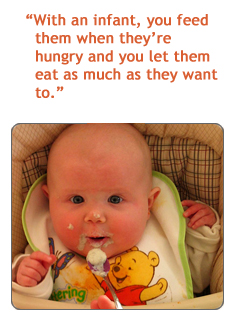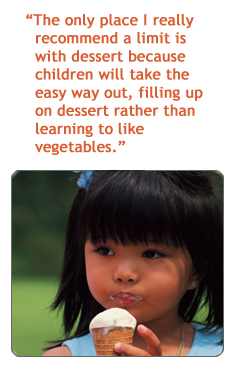  The following is part 1 of an interview with Ellyn Satter, author of numerous books on family nutrition, including Your Child’s Weight, Helping Without Harming. She has some ideas that may be different than what you have heard before – read the interview, then let us know what you think.
SYNERGY: I was interested in your perspective on obesity in children. What do you tell parents which may be different from what they have heard before?
ES: Let me start with a story about the parents of girl who was almost 10 pounds when she was born, and who just loved to eat. The parents found it quite terrifying because they thought a big baby who loves to eat leads to an overweight grownup. As long as the little girl was an infant, they were able to give her less than she really wanted to eat. But when this child became a toddler, it became terrible because she was so unhappy and was hungry all the time. They were trying to keep her from eating.
The mother read my book and realized that rather than feeling like she had to control her daughter’s eating, she had to establish a division of responsibility in feeding. She realized that there was only so much that she should control. By trying to control how much her daughter ate, she was making matters a lot worse in the long run, and increasing the risk that her daughter would be overweight.
The division of responsibility was that the mom established the timing of meals and snacks, and decided what goes on the table at those times. Then, it was up to the daughter to decide how much she ate of what was put in front of her.
At first, the little girl ate a lot. Of course, this was frightening for the parents, but they kept their courage and made the leap of faith. After a few days the daughter settled down, did much less panhandling, and was eating moderately at meals and snacks. Sometimes she would eat a lot, other times not so much, and the mom felt much less anxious. This is different from that whole conventional idea of what parents have to do in order to address child weight problems.
 SYNERGY: So, originally the child was asking to eat quite a bit, and the mom was restricting the child?
ES: Right, she was always trying to stave her off.
SYNERGY: Then, after setting a new division of responsibility, what was she doing differently?
ES: Letting the little girl eat as much as she wanted of what the mom put before her. She was just relaxing and letting her eat until she got full.
With an infant, you feed them when they’re hungry and you let them eat as much as they want to. You feed them on demand. But starting when a child is around 12 to 15 months of age, you need structure. The parent takes over the what, when and where of feeding. The "when" is a meal at a set time, snack at a set time. Not letting the child panhandle for food and beverages between those times. Then, at the meal or at the snack, you let the child eat however much they want to.
SYNERGY: So, if they don’t eat their vegetables, and this happens night after night, do you just let that slide?
ES: Yes.
SYNERGY: Do you demand they eat their vegetables?
ES: No. If you try to make them eat their vegetables, or anything else that’s on the table, the research is absolutely clear that they will be less likely to eat those foods and enjoy them than if you simply put them on the table, enjoy them yourself, and don’t make a big deal out of it. Don’t pressure them, manipulate, cajole, persuade. Don’t do any of those things to try to get the child to eat. Just trust that eventually they’ll get around to tasting it and they’ll get around to swallowing it and, after 15 or 20 times, or for some kids after 10 years, they will learn to like it.
SYNERGY: So let’s say they don’t eat their vegetables and this occurs every night – are they allowed to have a dessert?
 ES: You must not use dessert for leverage to get kids to eat other foods because that teaches them that dessert is desirable and the other foods are not. It teaches them that the dessert is far more valuable than other foods. You don’t want to set up a culture of scarcity with desserts, because again the research is very clear that children who are deprived of foods that taste really good -- like high sugar, high-fat foods -- will overeat on those foods when they get the chance. They tend to become overweight.
The only place I really recommend a limit is with dessert because children will take the easy way out, filling up on dessert rather than learning to like vegetables. I’d have a dessert rule to support the child’s learning to like a variety of foods.
SYNERGY: You discouraged panhandling.
ES: Grazing and panhandling are not a good idea. That means letting kids eat and drink along with the TV, letting kids eat all the time instead of offering them structured meals and snacks. That disrupts the child’s ability to regulate food intake.
The core principle of dealing with a child’s overweight issues is structure -- when to eat, but not how much.
Next month in Synergy, the interview with Ellyn Satter continues. We’ll address the following questions – how important is it for meals to be healthy? How do you deal with teens? What is the role of exercise? Stay tuned!
EDITOR’S NOTE: What do you think -- does this make sense to you? Would it work in your household? Why or why not? Send your feedback to featuredstories@adamcorp.com
|